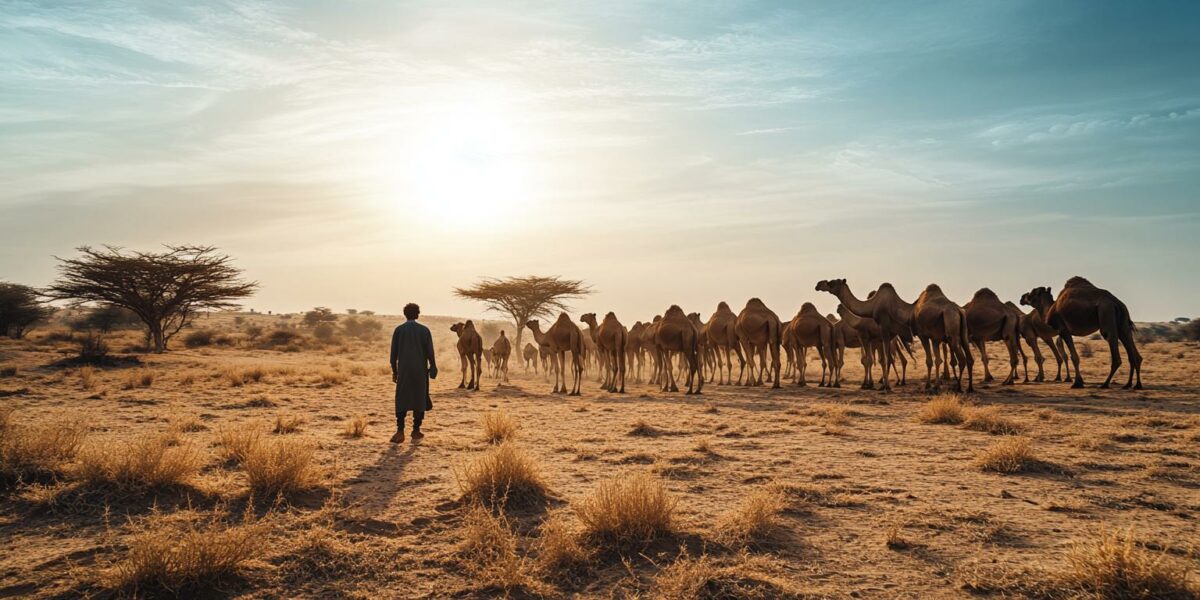Embracing Camels: A New Era for Kenyan Farmers
In Kenya, the harsh realities of climate change are pushing farmers to seek new ways to survive. Traditional cattle herding is no longer sustainable due to prolonged droughts. Instead, many are turning to camels, which prove to be more drought-resistant and better suited to the challenging conditions.
For the Borana and Samburu communities, cattle have long been a symbol of status and a vital source of milk and meat. However, the increasing frequency of droughts has decimated cattle populations, forcing farmers to find more resilient alternatives.
In Lekiji village, Abdulahi Mohamud, a 65-year-old camel herder, witnessed the devastating effects of the 2022 drought. “I had a herd of 30 cattle before the drought, but when it struck, only one survived,” he recalls. Now, he tends to 20 camels, which he believes are a safer investment.
The National Disaster Management Authority (NDMA) reported that the 2022 drought resulted in the loss of approximately 2.6 million cattle. In contrast, camels have shown remarkable resilience, thriving in conditions where cattle cannot.
The Economic Shift: Camels Versus Cattle
As the population grows, competition for grazing areas and water resources intensifies. Camels, which require less water and can graze on a broader range of plants, offer a practical solution. The economic benefits are also clear: a small camel sells for around $600 USD, whereas cows can be bought for about $150 USD.
According to the Kenya Agricultural Livestock Research Organization (KALRO), over 70% of Kenya’s land comprises rangelands. The shift towards camel farming is not just about survival but also about making informed economic decisions.
While camels make up only 6% of Kenya’s herbivore population, they provide significant advantages over cattle. These animals are better equipped to handle the heat and require fewer resources, making them a more sustainable option for farmers.
Here are some key benefits of camels:
- Less water-dependent
- Broader dietary range
- Heat resistance
Cultural Impacts and Adaptations
The transition from cattle to camels is also reshaping cultural practices. For the Samburu, cattle are essential in marriage ceremonies, symbolizing status and serving as dowry. Lesian Ole Sempere, a Samburu elder, emphasizes the importance of cattle in these traditions.
Despite the shift, the Samburu community remains committed to their cultural practices. They continue to incorporate camels into their herds, selling them when they need cattle for ceremonial purposes, thereby maintaining their cultural identity.
Calvince Okoth, a Veterinarian and Livestock Manager at Mpala Research Centre, notes the importance of rotational grazing to manage pastures effectively. However, communal land ownership poses a challenge, as unrestricted access can lead to overgrazing and degradation.
Climate change is causing unpredictable weather patterns, prompting the adoption of new agricultural methods. Some Maasai farmers have even turned to fish farming in response to the severe droughts affecting cattle populations.
Future Prospects: Will Camels Be Fully Embraced?
The long-term goal is to foster sustainable climate resilience. Incorporating camels into traditional herding practices offers a viable solution to the challenges posed by climate change. However, whether this shift will be fully embraced by all communities remains to be seen.
Camels offer not only a way to mitigate the adverse effects of climate change but also an opportunity to maintain food security and economic stability. The benefits are clear, but the transition requires time and adaptation.
As more farmers adopt camels, the hope is that this practice will spread, helping to preserve traditional pastoralist lifestyles in the 21st century. The resilience of camels makes them an ideal choice for the changing climate.
Ultimately, the decision to fully embrace camels will depend on various factors, including economic incentives, cultural acceptance, and the ongoing impacts of climate change.



tiggernebula
Great read! It’s sad that climate change is forcing such drastic changes, but it’s inspiring to see people adapting. 😊
Taylor
How do the local communities feel about this change? Are they embracing it fully?
liamdreamweaver
Fascinating shift in farming practices. Are there any downsides to raising camels?
Violet
I can’t believe cows are only $150! That’s cheap. But camels seem like a better investment.
thomasflux
Is there any government support for farmers making this transition?
bootslabyrinth
Camels are amazing creatures. It’s great to see them being appreciated for their resilience.
nala
Very interesting! How long do camels typically live compared to cattle?
haleyessence
Are camels easier to manage compared to cattle? Wondering if they require special care.
leahharmony0
This is a great adaptation to the climate crisis. Kudos to the Kenyan farmers for their resilience!
Ezekiel
Wow, I had no idea camels could be so beneficial! 🐪 Do they produce as much milk as cattle?